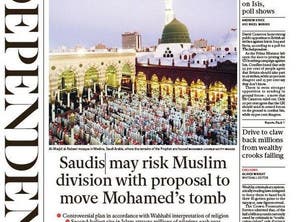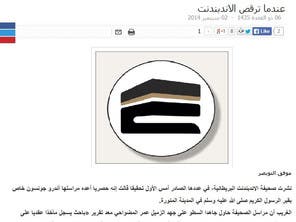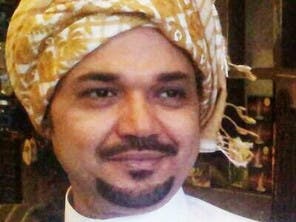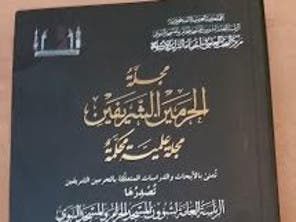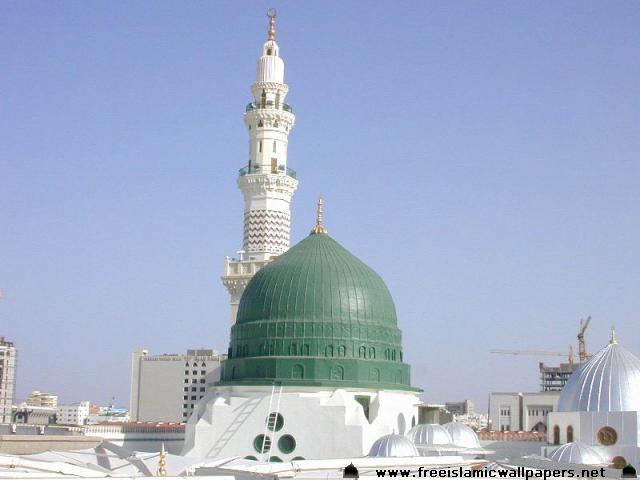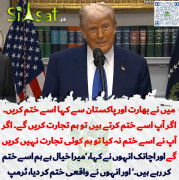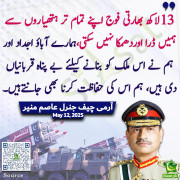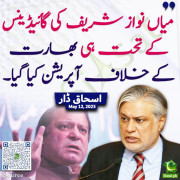Zoq_Elia
Senator (1k+ posts)
proposal to move Mohameds SAWW tomb
Saudis risk new Muslim division with proposal to move Mohamed’s tomb

Second-holiest site in Islam attracts millions of pilgrims each year
Andrew Johnson
Monday 01 September 2014
One of Islam’s most revered holy sites – the tomb of the Prophet Mohamed – could be destroyed and his body removed to an anonymous grave under plans which threaten to spark discord across the Muslim world.
The controversial proposals are part of a consultation document by a leading Saudi academic which has been circulated among the supervisors of al-Masjid al-Nabawi mosque in Medina, where the remains of the Prophet are housed under the Green Dome, visited by millions of pilgrims and venerated as Islam’s second-holiest site. The formal custodian of the mosque is Saudi Arabia’s ageing monarch King Abdullah.
The plans, brought to light by another Saudi academic who has exposed and criticised the destruction of holy places and artefacts in Mecca – the holiest site in the Muslim world – call for the destruction of chambers around the Prophet’s grave which are particularly venerated by Shia Muslims.
The 61-page document also calls for the removal of Mohamed’s remains to the nearby al-Baqi cemetery, where they would be interred anonymously.
There is no suggestion that any decision has been taken to act upon the plans. The Saudi government has in the past insisted that it treats any changes to Islam’s holiest sites with “the utmost seriousness”.
READ MORE: Attack on Mohamed's tomb could stir up sectarian hatred
But such is the importance of the mosque to both Sunni and Shia Muslims that Dr Irfan al-Alawi warned that any attempt to carry out the work could spark unrest. It also runs the risk of inflaming sectarian tensions between the two branches of Islam, already running perilously high due to the conflicts in Syria and Iraq.
Hardline Saudi clerics have long preached that the country’s strict Wahhabi interpretation of Islam – an offshoot of the Sunni tradition – prohibits the worship of any object or “saint”, a practice considered “shirq” or idolatrous.
Dr Alawi, director of the Islamic Heritage Research Foundation, told The Independent: “People visit the chambers, which are the rooms where the Prophet’s family lived, and turn towards the burial chamber to pray.
“Now they want to prevent pilgrims from attending and venerating the tomb because they believe this is shirq, or idolatry. But the only way they can stop people visiting the Prophet is to get him out and into the cemetery.”
For centuries Muslim pilgrims have made their way to Mecca in order to visit the Kaaba – a black granite cubed building said to be built by Abraham, around which al-Masjid al-Haram, or the Grand Mosque, is built, and towards which every Muslim faces when they pray.
This pilgrimage, or hajj, is a religious duty that has to be carried out at least once in a lifetime.
Many go on to make their way to the nearby city of Medina to pay their respects at the Prophet’s tomb.

Muslims waiting to pray at the tomb of the Prophet at al-Masjid al-Nabawi in Medina (Reuters)
Al-Nabawi mosque around the tomb has been expanded by generations of Arabian rulers, particularly the Ottomans. It includes hand-painted calligraphy documenting details of the Prophet’s life and his family. Dr Alawi said the plans also call for these to be destroyed as well as the Green Dome which covers the Prophet’s tomb.
The Prophet is venerated by both branches of Islam, Sunni and Shia. The strict Wahhabi sect is a branch of the Sunni faith, however, and removing the Prophet could further inflame tensions between the two groups .
The current crisis in Iraq has been blamed on the Shia former Prime Minister Nouri al-Maliki’s sectarianism, which alienated the Sunni, leading to the uprising. Isis, also known as Islamic State, which holds swathes of Iraq and Syria, and which murdered the American journalist James Foley, is a Sunni organisation.
Mainstream Sunni Muslims would be just as aghast at any desecration of the tomb as the Shia, Dr Alawi said.
The Independent has previously revealed how the multibillion-pound expansion of the Grand Mosque has, according to the Washington-based Gulf Institute, led to the destruction of up to 95 per cent of Mecca’s millennium-old buildings. They have been replaced with luxury hotels, apartments and shopping malls.
King Abdullah has appointed the prominent Wahhabi cleric and imam of the Grand Mosque, Abdul Rahman al-Sudais, to oversee the expansion project – necessary to cope with the huge number of pilgrims who now visit each year.
Dr Alawi says the consultation document for the al-Nabawi mosque in Medina, by the leading Saudi academic Dr Ali bin Abdulaziz al-Shabal of Imam Muhammad ibn Saud Islamic University in Riyadh, has been circulated to the Committee of the Presidency of the Two Mosques.
Several pages of the consultation document have just been published in the presidency’s journal. They call for the destruction of the rooms surrounding the tomb – used by the Prophet’s wives and daughters, and venerated by the Shia because of their association with his youngest daughter, Fatima.
The document also calls for the Green Dome, which covers the tomb and these living quarters, to be removed, and the ultimate removal of the Prophet’s body to a nearby cemetery.
The al-Baqi cemetery already contains the bodies of many of the Prophet’s family, including his father who was removed there in the 1970s, Dr Alawi said. In 1924 all the grave markers were removed, so pilgrims would not know who was buried there, and so be unable to pray to them.
“The Prophet would be anonymous,” Dr Alawi added. “Everything around the Prophet’s mosque has already been destroyed. It is surrounded by bulldozers. Once they’ve removed everything they can move towards the mosque. The imam is likely to say there is a need to expand the mosque and do it that way, while the world’s eyes are on Iraq and Syria. The Prophet Mohamed’s grave is venerated by the mainstream Sunni, who would never do it. It is just as important for the Shia too, who venerate the Prophet’s daughter, Fatima.
“I’m sure there will be shock across the Muslim world at these revelations. It will cause outrage.”
The Independent was unable to contact the Saudi Arabian embassy, but it said in a statement last year: “The development of the Holy Mosque of Makkah al-Mukarramah [Mecca] is an extremely important subject and one which the Kingdom of Saudi Arabia, in its capacity as custodian of the two holy mosques, takes with the utmost seriousness. This role is at the heart of the principles upon which Saudi Arabia is founded.”
Source:
http://www.independent.co.uk/news/world/middle-east/saudis-risk-new-muslim-division-with-proposal-to-move-mohameds-tomb-9705120.html
Note: It is Requested to All Siasat.pk members that Read above articals and watch Videos carefully and give your deep analysis. Thank you.
Saudis risk new Muslim division with proposal to move Mohamed’s tomb

Second-holiest site in Islam attracts millions of pilgrims each year
Andrew Johnson
Monday 01 September 2014
One of Islam’s most revered holy sites – the tomb of the Prophet Mohamed – could be destroyed and his body removed to an anonymous grave under plans which threaten to spark discord across the Muslim world.
The controversial proposals are part of a consultation document by a leading Saudi academic which has been circulated among the supervisors of al-Masjid al-Nabawi mosque in Medina, where the remains of the Prophet are housed under the Green Dome, visited by millions of pilgrims and venerated as Islam’s second-holiest site. The formal custodian of the mosque is Saudi Arabia’s ageing monarch King Abdullah.
The plans, brought to light by another Saudi academic who has exposed and criticised the destruction of holy places and artefacts in Mecca – the holiest site in the Muslim world – call for the destruction of chambers around the Prophet’s grave which are particularly venerated by Shia Muslims.
The 61-page document also calls for the removal of Mohamed’s remains to the nearby al-Baqi cemetery, where they would be interred anonymously.
There is no suggestion that any decision has been taken to act upon the plans. The Saudi government has in the past insisted that it treats any changes to Islam’s holiest sites with “the utmost seriousness”.
READ MORE: Attack on Mohamed's tomb could stir up sectarian hatred
But such is the importance of the mosque to both Sunni and Shia Muslims that Dr Irfan al-Alawi warned that any attempt to carry out the work could spark unrest. It also runs the risk of inflaming sectarian tensions between the two branches of Islam, already running perilously high due to the conflicts in Syria and Iraq.
Hardline Saudi clerics have long preached that the country’s strict Wahhabi interpretation of Islam – an offshoot of the Sunni tradition – prohibits the worship of any object or “saint”, a practice considered “shirq” or idolatrous.
Dr Alawi, director of the Islamic Heritage Research Foundation, told The Independent: “People visit the chambers, which are the rooms where the Prophet’s family lived, and turn towards the burial chamber to pray.
“Now they want to prevent pilgrims from attending and venerating the tomb because they believe this is shirq, or idolatry. But the only way they can stop people visiting the Prophet is to get him out and into the cemetery.”
For centuries Muslim pilgrims have made their way to Mecca in order to visit the Kaaba – a black granite cubed building said to be built by Abraham, around which al-Masjid al-Haram, or the Grand Mosque, is built, and towards which every Muslim faces when they pray.
This pilgrimage, or hajj, is a religious duty that has to be carried out at least once in a lifetime.
Many go on to make their way to the nearby city of Medina to pay their respects at the Prophet’s tomb.

Muslims waiting to pray at the tomb of the Prophet at al-Masjid al-Nabawi in Medina (Reuters)
The Prophet is venerated by both branches of Islam, Sunni and Shia. The strict Wahhabi sect is a branch of the Sunni faith, however, and removing the Prophet could further inflame tensions between the two groups .
The current crisis in Iraq has been blamed on the Shia former Prime Minister Nouri al-Maliki’s sectarianism, which alienated the Sunni, leading to the uprising. Isis, also known as Islamic State, which holds swathes of Iraq and Syria, and which murdered the American journalist James Foley, is a Sunni organisation.
Mainstream Sunni Muslims would be just as aghast at any desecration of the tomb as the Shia, Dr Alawi said.
The Independent has previously revealed how the multibillion-pound expansion of the Grand Mosque has, according to the Washington-based Gulf Institute, led to the destruction of up to 95 per cent of Mecca’s millennium-old buildings. They have been replaced with luxury hotels, apartments and shopping malls.
King Abdullah has appointed the prominent Wahhabi cleric and imam of the Grand Mosque, Abdul Rahman al-Sudais, to oversee the expansion project – necessary to cope with the huge number of pilgrims who now visit each year.
Dr Alawi says the consultation document for the al-Nabawi mosque in Medina, by the leading Saudi academic Dr Ali bin Abdulaziz al-Shabal of Imam Muhammad ibn Saud Islamic University in Riyadh, has been circulated to the Committee of the Presidency of the Two Mosques.
Several pages of the consultation document have just been published in the presidency’s journal. They call for the destruction of the rooms surrounding the tomb – used by the Prophet’s wives and daughters, and venerated by the Shia because of their association with his youngest daughter, Fatima.
The document also calls for the Green Dome, which covers the tomb and these living quarters, to be removed, and the ultimate removal of the Prophet’s body to a nearby cemetery.
The al-Baqi cemetery already contains the bodies of many of the Prophet’s family, including his father who was removed there in the 1970s, Dr Alawi said. In 1924 all the grave markers were removed, so pilgrims would not know who was buried there, and so be unable to pray to them.
“The Prophet would be anonymous,” Dr Alawi added. “Everything around the Prophet’s mosque has already been destroyed. It is surrounded by bulldozers. Once they’ve removed everything they can move towards the mosque. The imam is likely to say there is a need to expand the mosque and do it that way, while the world’s eyes are on Iraq and Syria. The Prophet Mohamed’s grave is venerated by the mainstream Sunni, who would never do it. It is just as important for the Shia too, who venerate the Prophet’s daughter, Fatima.
“I’m sure there will be shock across the Muslim world at these revelations. It will cause outrage.”
The Independent was unable to contact the Saudi Arabian embassy, but it said in a statement last year: “The development of the Holy Mosque of Makkah al-Mukarramah [Mecca] is an extremely important subject and one which the Kingdom of Saudi Arabia, in its capacity as custodian of the two holy mosques, takes with the utmost seriousness. This role is at the heart of the principles upon which Saudi Arabia is founded.”
Source:
http://www.independent.co.uk/news/world/middle-east/saudis-risk-new-muslim-division-with-proposal-to-move-mohameds-tomb-9705120.html
AL-Arabia Reply
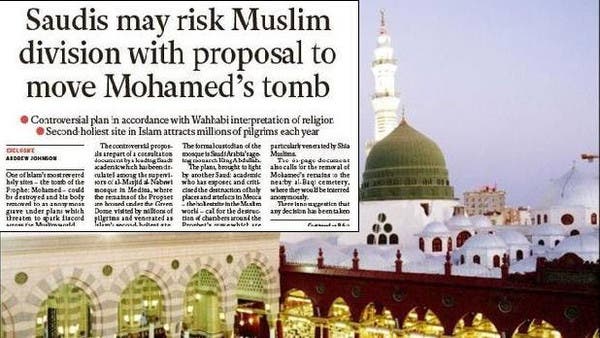
The British newspaper had reported that the tomb of the Prophet Mohammad in the holy city of Madinah could be “destroyed” and the Prophet’s remains removed. (Photo: The Independent)
The publication which featured the study, published on behalf of the General Presidency of the Two Holy mosques. (Courtesy: Mudhwahi)
دراسة عقدية تطالب بعزل حجرات النبي في المسجد النبوي
طالب باحث أكاديمي بإخراج وعزل حجرات النبي صلى الله عليه وسلم من حرم المسجد النبوي الشريف، كونه اتخذ ذريعة عند المخالفين لبناء المساجد على القبور والأضرحة، وفصلها بجدار يصل ما بين شرقي الحجرة مع شمالها إلى ما يسمى بدكة أهل الصفة حتى تكون الحجرة خارج المسجد الذي يصلى فيه.
واستعرض عضو هيئة التدريس في جامعة الإمام محمد بن سعود الإسلامية في الرياض الدكتور علي بن عبدالعزيز الشبل في دراسة جاءت تحت عنوان عمارة مسجد النبي عليه السلام ودخول الحجرات فيه دراسة عقدية تاريخ عمارة المسجد النبوي ابتداء من عمارة الوليد بن عبدالملك الخليفة الأموي في آخر المئة الأولى الهجرية وما بعدها.
وقال إن هذا البحث جاء استقراء لهذه العمارة فما بعدها من العمارات على مدى التاريخ.
وشدد الشبل التنبيه على المآخذ العقدية التي قامت بإدخال حجرات أمهات المؤمنين إلى المسجد ومنها حجرة أم المؤمنين عائشة رضي الله عنها، المشتملة على قبر النبي صلى الله عليه وسلم وقبر صاحبيه أبي بكر وعمر رضي الله عنهما وكذا المبالغة في تشييد بناء المسجد وزخرفته مشابهة لأهل الكتاب، مؤكدا أن موقف التابعين من عمارة الوليد كان النكارة وعدم الرضا بهذا الصنيع.
وختم الباحث توصياته بالمطالبة بتشكيل لجنة متخصصة من أهل العلم المعروفين بسلامة المعتقد وصدق التوحيد، لدراسة حاجة المسجد النبوي الشريف وتتبع ما فيه من البدع المحدثات ذات الخطر على الدين والعقيدة، ومتابعة منفذ مشروع توسعة خادم الحرمين في تجديداته داخل المسجد المجيدي وفي التوسعة الجديدة.
يذكر أن المجلة العلمية المحكمة تصدر عن مركز البحث العلمي وإحياء التراث الإسلامي التابع للرئاسة العامة لشؤون المسجد الحرام والمسجد النبوي وهي مجلة دورية تصدر كل أربعة أشهر، ونشرت الدراسة في 61 صفحة من عددها الأول جمادى الأولى المنصرم، وتعنى بالأبحاث والدراسات المتعلقة بالحرمين الشريفين.
Saudi newspaper accuses The Independent of theft and mistranslation

By Eman El-Shenawi | Al Arabiya News
Wednesday, 3 September 2014
The Deputy Editor-in-Chief of a Saudi Arabian newspaper has accused Britain’s The Independent of “theft,” claiming they have “robbed” one of their journalists of his efforts.
The Independent reported on Monday that the tomb of the Prophet Mohammad in the holy city of Madinah could be “destroyed” and the Prophet’s remains removed to an anonymous grave.
Wednesday, 3 September 2014
The Deputy Editor-in-Chief of a Saudi Arabian newspaper has accused Britain’s The Independent of “theft,” claiming they have “robbed” one of their journalists of his efforts.
The Independent reported on Monday that the tomb of the Prophet Mohammad in the holy city of Madinah could be “destroyed” and the Prophet’s remains removed to an anonymous grave.
But in an editorial on Wednesday, Mowafaq al-Nowaysar – Deputy Editor in Chief of Saudi Arabia’s “Makkah” Newspaper said that The Independent “fell in the trap of misunderstandings after it mistranslated” an Arabic article that was posted in Makkah Newspaper on Aug. 25.
Mowafaq al-Nowaysar's article accusing The Independent of theft
The article states that there are calls for the Prophet’s tomb to be “isolated,” not destroyed, explained Nowaysar, who also accused The Independent of previously stealing content from his newspaper.
Omar al-Mudhwahi is offering to provide the British newspaper with the correct translation of the study.
Speaking to Al Arabiya News on Wednesday, Omar al-Mudhwahi, the Saudi journalist who wrote the Makkah newspaper report said: “If they insist on stealing my work, at least they should allow me to provide them with an accurate translation … I would be glad to”.
“I had initially written about the proposal after reading a study by Saudi academic Dr. Ali bin Abdulaziz al-Shabal in a publication published on behalf of the General Presidency of the Two Holy mosques.”
Speaking to Al Arabiya News on Wednesday, Omar al-Mudhwahi, the Saudi journalist who wrote the Makkah newspaper report said: “If they insist on stealing my work, at least they should allow me to provide them with an accurate translation … I would be glad to”.
“I had initially written about the proposal after reading a study by Saudi academic Dr. Ali bin Abdulaziz al-Shabal in a publication published on behalf of the General Presidency of the Two Holy mosques.”
The publication which featured the study, published on behalf of the General Presidency of the Two Holy mosques. (Courtesy: Mudhwahi)
In response to the allegations of “theft,” Deputy Managing Editor at The Independent, Will Gore, told Al Arabiya News on Wednesday they were “not aware of Makkah’s report” a week earlier.
“The information for our article was brought to our attention by the Saudi academic Dr. Irfan al-Alawi, who had read directly the work of Dr. Ali bin Abdulaziz al-Shabal and was concerned by its content. This follows on from previous Independent articles over recent years about the approach of the Saudi authorities to historical sites in Makkah and Madinah,” Gore said.
The Independent is claiming the story as an exclusive, and many British news sites carrying the news have credited the paper as breaking the story.
The Independent story also didn’t include any confirmation or comment from any Saudi officials. For its part, Al Arabiya has obtained a comment from government sources which confirmed that the whole issue isn’t more than a “proposal by an academic which was published in a specialized magazine and is not a government decision.”
Last Update: Thursday, 4 September 2014 KSA 17:11 - GMT 14:11
“The information for our article was brought to our attention by the Saudi academic Dr. Irfan al-Alawi, who had read directly the work of Dr. Ali bin Abdulaziz al-Shabal and was concerned by its content. This follows on from previous Independent articles over recent years about the approach of the Saudi authorities to historical sites in Makkah and Madinah,” Gore said.
The Independent is claiming the story as an exclusive, and many British news sites carrying the news have credited the paper as breaking the story.
The Independent story also didn’t include any confirmation or comment from any Saudi officials. For its part, Al Arabiya has obtained a comment from government sources which confirmed that the whole issue isn’t more than a “proposal by an academic which was published in a specialized magazine and is not a government decision.”
Last Update: Thursday, 4 September 2014 KSA 17:11 - GMT 14:11
Source:
Below is the cached version of "an Arabic article that was posted in Makkah Newspaper" as Original Article is Removed and cannot Accessible.
باحث يسجل مأخذا عقديا على وجود قبر الرسول في المسجد
27 شوال 1435 - 24 أغسطس 2014
31
[*=right]
[*=center] عمر المضواحي - مكة المكرمة
دراسة عقدية تطالب بعزل حجرات النبي في المسجد النبوي
طالب باحث أكاديمي بإخراج وعزل حجرات النبي صلى الله عليه وسلم من حرم المسجد النبوي الشريف، كونه اتخذ ذريعة عند المخالفين لبناء المساجد على القبور والأضرحة، وفصلها بجدار يصل ما بين شرقي الحجرة مع شمالها إلى ما يسمى بدكة أهل الصفة حتى تكون الحجرة خارج المسجد الذي يصلى فيه.
واستعرض عضو هيئة التدريس في جامعة الإمام محمد بن سعود الإسلامية في الرياض الدكتور علي بن عبدالعزيز الشبل في دراسة جاءت تحت عنوان عمارة مسجد النبي عليه السلام ودخول الحجرات فيه دراسة عقدية تاريخ عمارة المسجد النبوي ابتداء من عمارة الوليد بن عبدالملك الخليفة الأموي في آخر المئة الأولى الهجرية وما بعدها.
وقال إن هذا البحث جاء استقراء لهذه العمارة فما بعدها من العمارات على مدى التاريخ.
وشدد الشبل التنبيه على المآخذ العقدية التي قامت بإدخال حجرات أمهات المؤمنين إلى المسجد ومنها حجرة أم المؤمنين عائشة رضي الله عنها، المشتملة على قبر النبي صلى الله عليه وسلم وقبر صاحبيه أبي بكر وعمر رضي الله عنهما وكذا المبالغة في تشييد بناء المسجد وزخرفته مشابهة لأهل الكتاب، مؤكدا أن موقف التابعين من عمارة الوليد كان النكارة وعدم الرضا بهذا الصنيع.
وختم الباحث توصياته بالمطالبة بتشكيل لجنة متخصصة من أهل العلم المعروفين بسلامة المعتقد وصدق التوحيد، لدراسة حاجة المسجد النبوي الشريف وتتبع ما فيه من البدع المحدثات ذات الخطر على الدين والعقيدة، ومتابعة منفذ مشروع توسعة خادم الحرمين في تجديداته داخل المسجد المجيدي وفي التوسعة الجديدة.
يذكر أن المجلة العلمية المحكمة تصدر عن مركز البحث العلمي وإحياء التراث الإسلامي التابع للرئاسة العامة لشؤون المسجد الحرام والمسجد النبوي وهي مجلة دورية تصدر كل أربعة أشهر، ونشرت الدراسة في 61 صفحة من عددها الأول جمادى الأولى المنصرم، وتعنى بالأبحاث والدراسات المتعلقة بالحرمين الشريفين.
توصيات الدراسة:
[*=right] 1 - المطالبة بهدم الجدار القبلي (العثماني المجيدي) وتوسيع مقدمة المسجد إلى الجنوب.
[*=right] 2 - طمس الأبيات الشعرية من قصائد المدح المكتوبة في محيط الحجرة وعلى الاسطوانات وعدم تجديدها بالرخام الحديث حماية لجناب التوحيد، ودرءا لشر الشرك والتوسل والاستغاثة بالرسول صلى الله عليه وسلم قي مقبرة وهو ميت.
[*=right] 3 - طمس أسماء الصحابة والأئمة الاثني عشر من الحصوتين دفعا للمفاسد المترتبة على وجودها.
[*=right] 4 - عدم تجديد طلاء القبة الخضراء وإزالة النحاس الذي عليها كحد أدنى.
مطالبة غير منطقية
[*=right] تؤكد التوصيات عدم إلمام الكاتب بأبسط معارف تاريخ المسجد النبوي الموجودة في شواهد البناء العثماني، والتي توضح المواقع الشرعية وفق اجتهاد الفقهاء في تحديد موضع الروضة، ومن الآراء تقول أن آخر حدود بيوت النبي صلى الله عليه وسلم تابعة للروضة؛ لذلك ميزوها بالأسطوانات البيضاء التي تمتد إلى نهاية الحجرة جهة الشرق. كما أن جدار القبلة الحالي هو الحد النهائي الذي وقف عنده سيدنا عثمان رضي الله عنه فلم يتجاوزه، ولم يتجاوزه كل من جاء بعده حتى يومنا هذا، فهو ينتهي عند حجرة أم المؤمنين السيدة صفية رضي الله عنها، وهي نهاية حدود الحجرات.
المهندس عبدالحق العقبي - الباحث في تاريخ المدينة المنورة والخبير في العمارة الإسلامية
Note: It is Requested to All Siasat.pk members that Read above articals and watch Videos carefully and give your deep analysis. Thank you.
Last edited:

